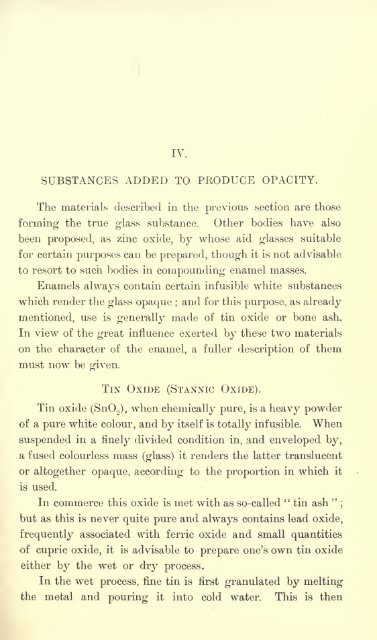Enamels and enamelling; an introduction to the preparation and ...
Enamels and enamelling; an introduction to the preparation and ...
Enamels and enamelling; an introduction to the preparation and ...
You also want an ePaper? Increase the reach of your titles
YUMPU automatically turns print PDFs into web optimized ePapers that Google loves.
IV.<br />
SUBSTANCES ADDED TO PRODUCE OPACITY.<br />
The materials described in <strong>the</strong> previous section are those<br />
forming <strong>the</strong> true glass subst<strong>an</strong>ce. O<strong>the</strong>r bodies have also<br />
been proposed, as zinc oxide, by whose aid glasses suitable<br />
for certain purposes c<strong>an</strong> be prepared, though it is not advisable<br />
<strong>to</strong> resort <strong>to</strong> such bodies in compounding enamel masses.<br />
<strong>Enamels</strong> always contain certain infusible white subst<strong>an</strong>ces<br />
which render <strong>the</strong> glass opaque ;<br />
<strong><strong>an</strong>d</strong> for this purpose, as already<br />
mentioned, use is generally made of tin oxide or bone ash.<br />
In view of <strong>the</strong> great influence exerted by <strong>the</strong>se two materials<br />
on <strong>the</strong> character of <strong>the</strong> enamel, a fuller description of <strong>the</strong>m<br />
must now be given.<br />
TIN OXIDE (STANNIC OXIDE).<br />
Tin oxide (SnO 2 ), when chemically pure, is a heavy powder<br />
of a pure white colour, <strong><strong>an</strong>d</strong> by itself is <strong>to</strong>tally infusible. When<br />
suspended in a finely divided condition in, <strong><strong>an</strong>d</strong> enveloped by,<br />
a fused colourless mass (glass) it renders <strong>the</strong> latter tr<strong>an</strong>slucent<br />
or al<strong>to</strong>ge<strong>the</strong>r opaque, according <strong>to</strong> <strong>the</strong> proportion in which it<br />
is used.<br />
In commerce this oxide is met with as so-called " tin ash " ;<br />
but as this is never quite pure <strong><strong>an</strong>d</strong> always contains lead oxide,<br />
frequently associated with ferric oxide <strong><strong>an</strong>d</strong> small qu<strong>an</strong>tities<br />
of cupric oxide, it is advisable <strong>to</strong> prepare one's own tin oxide<br />
ei<strong>the</strong>r by <strong>the</strong> wet or dry process.<br />
In <strong>the</strong> wet process, fine tin is first gr<strong>an</strong>ulated by melting<br />
<strong>the</strong> metal <strong><strong>an</strong>d</strong> pouring it in<strong>to</strong> cold water. This is <strong>the</strong>n
















